Champagne Drappier
by
Terry Sullivan
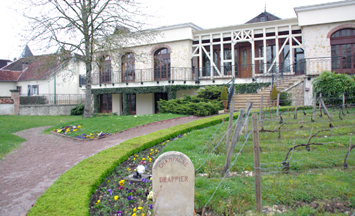 Summary: Champagne Drappier is a family-run champagne house in the Aube subregion of Champagne. It currently has three generations working at the winery. Visitors can expect to taste champagnes that have been crafted to showcase both history and the land. It is one of the few champagne houses that creates a champagne from the other white grapes that are permitted to be used in champagne production.
Summary: Champagne Drappier is a family-run champagne house in the Aube subregion of Champagne. It currently has three generations working at the winery. Visitors can expect to taste champagnes that have been crafted to showcase both history and the land. It is one of the few champagne houses that creates a champagne from the other white grapes that are permitted to be used in champagne production.
It was an overcast, cool and occasionally wet day that we visited Champagne Drappier in Urville. However, our reception was warm and welcoming. We headed to a room at the end of a hall that had a fire lit in the fireplace. Soon, Michel Drappier greeted us. Michel is the energetic and charming force behind the uniqueness of the champagne house. He spoke about family and how the family built this independent business. Starting in 1808 the family started making wine.
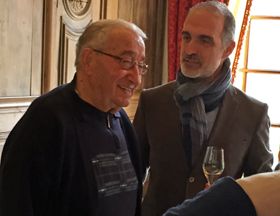 Michel is the seventh generation to craft champagnes. His children are also involved in the business. Michel also spoke lovingly about his father, André, noting that he is his best customer. On the other hand, he said with a twinkle in his eye, his father, who is still involved in the operation is also the worst customer since he does not pay for the champagne he drinks.
Michel is the seventh generation to craft champagnes. His children are also involved in the business. Michel also spoke lovingly about his father, André, noting that he is his best customer. On the other hand, he said with a twinkle in his eye, his father, who is still involved in the operation is also the worst customer since he does not pay for the champagne he drinks.
Vineyards
Michel talked about the area’s soils comparing them to nearby Chablis. Michel enjoys the minerality exhibited by Pinot Noir in these limestone soils. The Drappier house has vineyards that consist of 55 hectares (136 acres) and the house leases another 50 hectares. A small educational vineyard is planted in front of the champagne house. During our early April visit, the vines had been pruned but were still asleep. One can observe the architecture of the vines during the dormant period. About one-third of the vineyards are certified organic while the other two-thirds are farmed organically but have not received the certification at this time. The champagne house hires 25 people to harvest the grapes. The pickers scrutinize the grapes only selecting the best clusters.
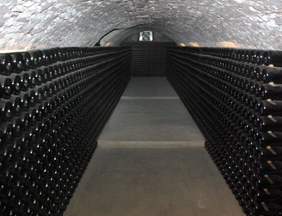 Caves
Caves
We gathered and followed Michel into the caves, 30 meters (98 feet) below ground level. The wine cellars in the basement were built in 1152 by the Cistercian monks of Clairvaux. Just as in the centuries from the past, wine is still crafted in these cellars. Our group stood in the portion of the cellars that are nearly 900 years old. An old wine press is on display at the end of one corridor. Some passageways were lined with horizontal champagne bottles neatly packed against the wall. Other bottles were angled in riddling racks at various degrees.
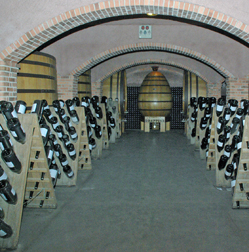 Our tour ambled into a barrel and wood tank area. The focus of this room is the wood egg-shaped barrel, an ovum. There are only a few of these barrels in France. It holds 2400 liters of wine and the first vintage, a 2012, is currently aging in the barrel. Eventually the wine will be made into champagne, but will not see a release date prior to 2019.
Our tour ambled into a barrel and wood tank area. The focus of this room is the wood egg-shaped barrel, an ovum. There are only a few of these barrels in France. It holds 2400 liters of wine and the first vintage, a 2012, is currently aging in the barrel. Eventually the wine will be made into champagne, but will not see a release date prior to 2019.
Winemaking
As far as some winemaking practices go, we learned that Champagne Drappier does not follow the mold but creates their own unique styles. Wines undergo malolactic fermentation. The grapes in this area of the Aube have a lower acidity and as a result Michel adds a lower dosage to create a balanced champagne. Most of the wines are in the middle of reductive and oxidative, although those champagnes in magnums tend to be a bit more reductive. Other winemaking practices include low temperature fermentation and no filtering. These practices help create champagnes that have a lot of small lazy bubbles ascending to the surface of the liquid forming a mousse. It is estimated that there are between 50 and 60 million bubbles.
From a winery point of view, the winery uses solar power and now that energy accounts for 55 percent of the winery’s needs. The goal is to be 100 percent solar powered in the future.
Michel spent time discussing the sugar used in the dosage. He creates a very old liqueur that measures 714 grams of sugar per liter. He matures this mixture for 15 years in an oak tank. At least one drop of this liqueur de dosage is added to each bottle of champagne. The old sugar brings out floral notes and toasted bread notes. One does not notice a sugary taste when tasting the champagnes.
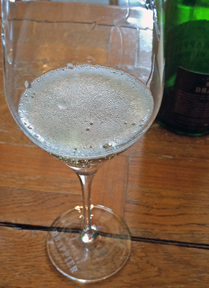 Champagnes
Champagnes
We tasted three champagnes including one of the most unique champagnes since we have been in the Champagne area. Our first champagne was a Brut Nature. It was a light yellow color made entirely of Pinot Noir. The champagne had a zero dosage and showed very fine bubbles forming a large mousse. There were red berries and peaches on the aroma and taste.
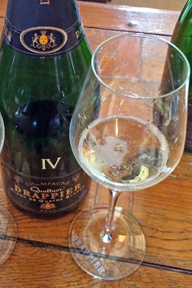 The unique champagne was the Blanc de Quatre Blancs. This champagne is unique in that it is a blend of the white grapes that are permitted to be used to make champagne in the Champagne region. The blend consists equally of the grapes Arbane, Petit Meslier, Formenteau (Pinot Gris) and Chardonnay. The light yellow color champagne had many columns of beads that formed a large mousse on the surface. The wine offered yellow stone fruit on the aroma and taste and had a citrus finish. Champagnes used with these traditional grapes only account for 0.3 percent of the champagne production. This was a special champagne to taste.
The unique champagne was the Blanc de Quatre Blancs. This champagne is unique in that it is a blend of the white grapes that are permitted to be used to make champagne in the Champagne region. The blend consists equally of the grapes Arbane, Petit Meslier, Formenteau (Pinot Gris) and Chardonnay. The light yellow color champagne had many columns of beads that formed a large mousse on the surface. The wine offered yellow stone fruit on the aroma and taste and had a citrus finish. Champagnes used with these traditional grapes only account for 0.3 percent of the champagne production. This was a special champagne to taste.
The Grande Sendrée was a blend of 55% Pinot Noir and 45% Chardonnay. It was disgorged in February of 2014. The wine had a light yellow color with many columns of beads forming a large mousse. The champagne had aromas and tastes of red berry fruits and apple on the finish. The name is a historical misspelling of the word cendrée (cindered). The name refers to a fire that destroyed much of Urville in 1836. The Rosé Brut was a red with orange hue color. The 100% Pinot Noir champagne had multiple columns of fine beads forming a large mousse on the surface. The wine had red berry fruit on the aroma and taste. The rosé color was obtained using the saignée method, the Pinot Noir was macerated on the skins for three days. The wine went through natural malolactic fermentation. The dosage measured 7.5 grams of sugar per liter.
Wine Tourism
Champagne Drappier is open for tours and tastings Mondays thrugh Saturdays. They are closed on Sundays. Wine tourists must call to make an appointment.
Champagne Drappier
Rue des vignes, 10200 Urville
+33 (0) 325 27 40 15
Article written April 2015
Visit these tour operators that partner with Wine Trail Traveler.
 |
||||
France
|
France
|
France | SmoothRed London, England, United Kingdom |


